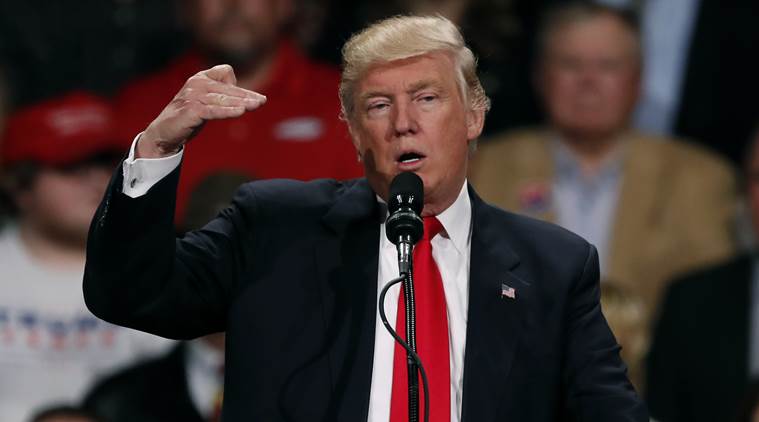Raja-Mandala: The challenge of automata
Source: C. Raja Mohan
 President-elect Donald Trump (Source: AP)
President-elect Donald Trump (Source: AP)
That the US president elect Donald Trump has spoken up against H-1B visas, which go mostly to Indian IT companies, is no surprise. Last week at a “thank-you rally” in Iowa, Trump promised to end the abuse of Washington’s visa policies by US firms that have replaced American engineers with cheaper foreign skilled workers. He was referring to an incident that involved Disney World in Orlando, Florida and a couple of Indian companies and IT professionals on H-1B visas.
Trump did not name India or the companies, but the message was loud and clear. The US policy on H-1B visas has been under fire from many quarters of the US establishment — from the IT trade unions to the liberal New York Times, which ran a series of stories last year, on how the Indian companies had gamed the US visa policy to the detriment of American workers. As they come to terms with the new political reality shaping the insourcing and outsourcing of work in America, Delhi and Bengaluru must also look beyond Trump to focus on the unfolding technological transformation that will begin to test the business model of the Indian IT industry. But first to America, where Trump has signaled his intent to follow through his rhetoric over the past one year on protecting American jobs. Through the presidential campaign, Trump railed against the American financial and industrial elites for pursuing globalisation despite its massive job losses in America. By promising to overturn trade agreements and penalising American companies moving jobs abroad, Trump secured that small edge over his Democratic rival, Hillary Clinton, in the mid-western industrial heartland of America. Although Clinton won nearly 2.8 million votes more than Trump across America, she lost narrowly to Trump in Michigan (by 10,000 votes), Wisconsin (22,000) and Pennsylvania (45,000). By edging past Clinton in these states, Trump secured a majority in the electoral college and the presidency. Since his election, Trump has made it quite clear that he will stick by his hard line on saving American jobs and stand by those who propelled him to the White House.
Trump has nominated Senator Jeff Sessions, a strong opponent of H1-B visa policy, to be his attorney general. Last year, Sessions had introduced a bill in the Senate for a comprehensive reform of the H 1-B visa system. Trump also announced a deal with Carrier, a company that makes air conditioners, to keep its facility in Indiana. During his campaign, Trump had attacked Carrier for its plans to move the plant to Mexico. On the left, many have dismissed the Carrier deal as a cosmetic gesture of political support to American workers. On the right, Trump has been criticised for abandoning free market principles and “arm twisting” Carrier. The Wall Street Journal, the voice of American capitalism, warned that Trump’s deal with Carrier would reduce the company’s ability to compete in the global market and will eventually cost more American jobs. The journal argued that “Trump’s Carrier squeeze might even cost more US jobs if it makes CEOs more reluctant to build plants in the US because it would be politically difficult to close them.” But all recent surveys show strong public support to Trump’s attempts to save American jobs.
In an ironic twist to the entire episode, Carrier announced that its new investments in the Indiana facility will focus on automating the plant and replacing the workers with robots. Over the long term the prospect that workers could be replaced with machines could be far more consequential than the current intense arguments between protectionists and globalisers. The rapid advances in robotics, artificial intelligence (AI), and the integration of physical and biological worlds points to what many despair as a job-less future. In the past technological transformations created more jobs than those they eliminated. This time around, it could be different. Pessimists warn of mass unemployment around the world as the share of labour costs in production begins to decline precipitously.
If Trump can’t get back manufacturing jobs into America, the Indian IT industry might find it hard to sustain its business model based on arbitrage of skilled labour. American political backlash against globalisation is only part of Bengaluru’s problem. For automation threatens to eliminate not just many current jobs in the Indian IT industry but a range of well-paying white collar occupations around the world.
Delhi and Bengaluru must therefore start preparing India for the so-called fourth industrial revolution and its huge social and political implications. Together they must address a twin-challenge: On the one hand, they must facilitate massive investments in new technologies like robotics and AI and reduce the growing gap between Indian capabilities and other major economies. On the other hand, Delhi and Bengaluru must also mitigate the negative consequences of the technological revolution as well as imagine its many possibilities for transforming India. Complacence on technology policy is no longer an option.
| }
|